Sukhdeep Singh
Graph Neural Network based Handwritten Trajectories Recognition
May 15, 2024Abstract:The graph neural networks has been proved to be an efficient machine learning technique in real life applications. The handwritten recognition is one of the useful area in real life use where both offline and online handwriting recognition are required. The chain code as feature extraction technique has shown significant results in literature and we have been able to use chain codes with graph neural networks. To the best of our knowledge, this work presents first time a novel combination of handwritten trajectories features as chain codes and graph neural networks together. The handwritten trajectories for offline handwritten text has been evaluated using recovery of drawing order, whereas online handwritten trajectories are directly used with chain codes. Our results prove that present combination surpass previous results and minimize error rate in few epochs only.
GatedLexiconNet: A Comprehensive End-to-End Handwritten Paragraph Text Recognition System
Apr 22, 2024



Abstract:The Handwritten Text Recognition problem has been a challenge for researchers for the last few decades, especially in the domain of computer vision, a subdomain of pattern recognition. Variability of texts amongst writers, cursiveness, and different font styles of handwritten texts with degradation of historical text images make it a challenging problem. Recognizing scanned document images in neural network-based systems typically involves a two-step approach: segmentation and recognition. However, this method has several drawbacks. These shortcomings encompass challenges in identifying text regions, analyzing layout diversity within pages, and establishing accurate ground truth segmentation. Consequently, these processes are prone to errors, leading to bottlenecks in achieving high recognition accuracies. Thus, in this study, we present an end-to-end paragraph recognition system that incorporates internal line segmentation and gated convolutional layers based encoder. The gating is a mechanism that controls the flow of information and allows to adaptively selection of the more relevant features in handwritten text recognition models. The attention module plays an important role in performing internal line segmentation, allowing the page to be processed line-by-line. During the decoding step, we have integrated a connectionist temporal classification-based word beam search decoder as a post-processing step. In this work, we have extended existing LexiconNet by carefully applying and utilizing gated convolutional layers in the existing deep neural network. Our results at line and page levels also favour our new GatedLexiconNet. This study reported character error rates of 2.27% on IAM, 0.9% on RIMES, and 2.13% on READ-16, and word error rates of 5.73% on IAM, 2.76% on RIMES, and 6.52% on READ-2016 datasets.
An inclusive review on deep learning techniques and their scope in handwriting recognition
Apr 10, 2024Abstract:Deep learning expresses a category of machine learning algorithms that have the capability to combine raw inputs into intermediate features layers. These deep learning algorithms have demonstrated great results in different fields. Deep learning has particularly witnessed for a great achievement of human level performance across a number of domains in computer vision and pattern recognition. For the achievement of state-of-the-art performances in diverse domains, the deep learning used different architectures and these architectures used activation functions to perform various computations between hidden and output layers of any architecture. This paper presents a survey on the existing studies of deep learning in handwriting recognition field. Even though the recent progress indicates that the deep learning methods has provided valuable means for speeding up or proving accurate results in handwriting recognition, but following from the extensive literature survey, the present study finds that the deep learning has yet to revolutionize more and has to resolve many of the most pressing challenges in this field, but promising advances have been made on the prior state of the art. Additionally, an inadequate availability of labelled data to train presents problems in this domain. Nevertheless, the present handwriting recognition survey foresees deep learning enabling changes at both bench and bedside with the potential to transform several domains as image processing, speech recognition, computer vision, machine translation, robotics and control, medical imaging, medical information processing, bio-informatics, natural language processing, cyber security, and many others.
GTAGCN: Generalized Topology Adaptive Graph Convolutional Networks
Mar 22, 2024



Abstract:Graph Neural Networks (GNN) have emerged as a popular and standard approach for learning from graph-structured data. The literature on GNN highlights the potential of this evolving research area and its widespread adoption in real-life applications. However, most of the approaches are either new in concept or derived from specific techniques. Therefore, the potential of more than one approach in hybrid form has not been studied extensively, which can be well utilized for sequenced data or static data together. We derive a hybrid approach based on two established techniques as generalized aggregation networks and topology adaptive graph convolution networks that solve our purpose to apply on both types of sequenced and static nature of data, effectively. The proposed method applies to both node and graph classification. Our empirical analysis reveals that the results are at par with literature results and better for handwritten strokes as sequenced data, where graph structures have not been explored.
Melting Pot 2.0
Dec 13, 2022Abstract:Multi-agent artificial intelligence research promises a path to develop intelligent technologies that are more human-like and more human-compatible than those produced by "solipsistic" approaches, which do not consider interactions between agents. Melting Pot is a research tool developed to facilitate work on multi-agent artificial intelligence, and provides an evaluation protocol that measures generalization to novel social partners in a set of canonical test scenarios. Each scenario pairs a physical environment (a "substrate") with a reference set of co-players (a "background population"), to create a social situation with substantial interdependence between the individuals involved. For instance, some scenarios were inspired by institutional-economics-based accounts of natural resource management and public-good-provision dilemmas. Others were inspired by considerations from evolutionary biology, game theory, and artificial life. Melting Pot aims to cover a maximally diverse set of interdependencies and incentives. It includes the commonly-studied extreme cases of perfectly-competitive (zero-sum) motivations and perfectly-cooperative (shared-reward) motivations, but does not stop with them. As in real-life, a clear majority of scenarios in Melting Pot have mixed incentives. They are neither purely competitive nor purely cooperative and thus demand successful agents be able to navigate the resulting ambiguity. Here we describe Melting Pot 2.0, which revises and expands on Melting Pot. We also introduce support for scenarios with asymmetric roles, and explain how to integrate them into the evaluation protocol. This report also contains: (1) details of all substrates and scenarios; (2) a complete description of all baseline algorithms and results. Our intention is for it to serve as a reference for researchers using Melting Pot 2.0.
Lexicon and Attention based Handwritten Text Recognition System
Sep 11, 2022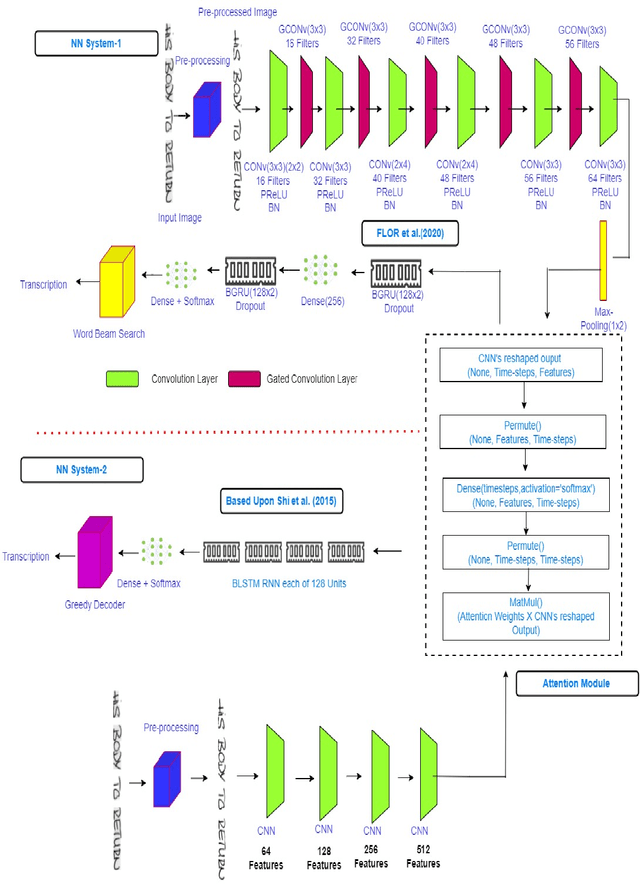

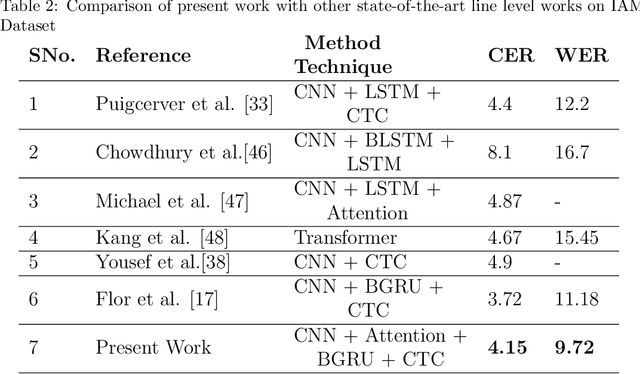
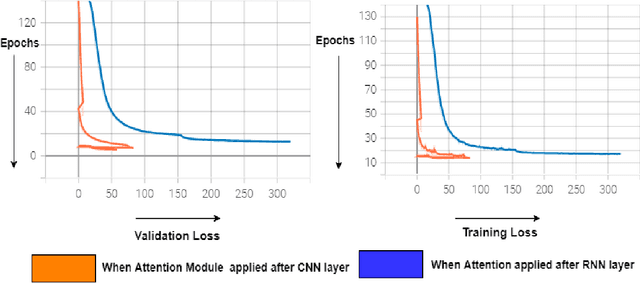
Abstract:The handwritten text recognition problem is widely studied by the researchers of computer vision community due to its scope of improvement and applicability to daily lives, It is a sub-domain of pattern recognition. Due to advancement of computational power of computers since last few decades neural networks based systems heavily contributed towards providing the state-of-the-art handwritten text recognizers. In the same direction, we have taken two state-of-the art neural networks systems and merged the attention mechanism with it. The attention technique has been widely used in the domain of neural machine translations and automatic speech recognition and now is being implemented in text recognition domain. In this study, we are able to achieve 4.15% character error rate and 9.72% word error rate on IAM dataset, 7.07% character error rate and 16.14% word error rate on GW dataset after merging the attention and word beam search decoder with existing Flor et al. architecture. To analyse further, we have also used system similar to Shi et al. neural network system with greedy decoder and observed 23.27% improvement in character error rate from the base model.
A Lexicon and Depth-wise Separable Convolution Based Handwritten Text Recognition System
Jul 11, 2022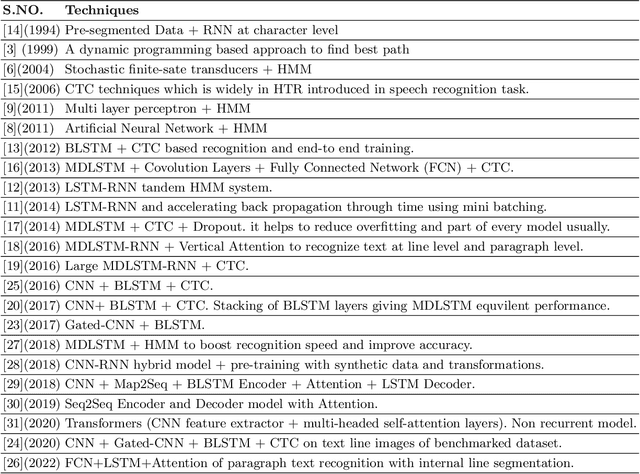
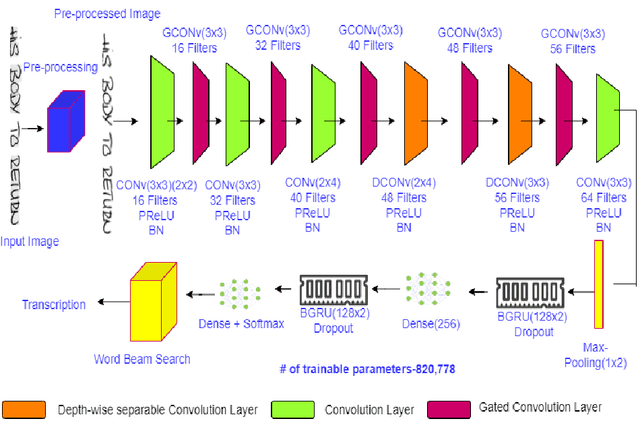
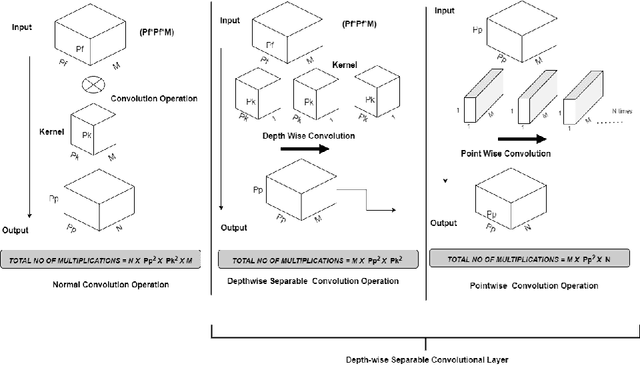

Abstract:Cursive handwritten text recognition is a challenging research problem in the domain of pattern recognition. The current state-of-the-art approaches include models based on convolutional recurrent neural networks and multi-dimensional long short-term memory recurrent neural networks techniques. These methods are highly computationally extensive as well model is complex at design level. In recent studies, combination of convolutional neural network and gated convolutional neural networks based models demonstrated less number of parameters in comparison to convolutional recurrent neural networks based models. In the direction to reduced the total number of parameters to be trained, in this work, we have used depthwise convolution in place of standard convolutions with a combination of gated-convolutional neural network and bidirectional gated recurrent unit to reduce the total number of parameters to be trained. Additionally, we have also included a lexicon based word beam search decoder at testing step. It also helps in improving the the overall accuracy of the model. We have obtained 3.84% character error rate and 9.40% word error rate on IAM dataset; 4.88% character error rate and 14.56% word error rate in George Washington dataset, respectively.
LexiconNet: An End-to-End Handwritten Paragraph Text Recognition System
May 23, 2022



Abstract:Historical documents present in the form of libraries needs to be digitised. The recognition of these unconstrained cursive handwritten documents is a challenging task. In the present work, neural network based classifier is used. The recognition of scanned document images which are easy to train on neural network based systems is usually done by a two step approach: segmentation followed by recognition. This approach has several shortcomings, which includes identification of text regions, layout diversity analysis present within pages and ground truth segmentation. These processes are prone to errors that create bottleneck in the recognition accuracies. Thus in this study, an end-to-end paragraph recognition system is presented with internal line segmentation and lexicon decoder as post processing step, which is free from those errors. We named our model as LexiconNet. In LexiconNet, given a paragraph image a combination of convolution and depth-wise separable convolutional modules generates the two dimension feature map of the image. The attention module is responsible for internal line segmentation that consequently processing a page in a line by line manner. At decoding step, we have added connectionist temporal classification based word beam search decoder as a post processing step. Our approach reports state-of-the-art results on standard datasets. The reported character error rate is 3.24% on IAM dataset with 27.19% improvement, 1.13% on RIMES with 40.83% improvement and 2.43% on READ-16 dataset with 32.31% improvement from existing literature and the word error rate is 8.29% on IAM dataset with 43.02% improvement, 2.94% on RIMES dataset with 56.25% improvement and 7.35% on READ-2016 dataset with 47.27% improvement from the existing results. The character error rate and word error rate reported in this work surpasses the results reported in literature.
Learning Robust Real-Time Cultural Transmission without Human Data
Mar 01, 2022
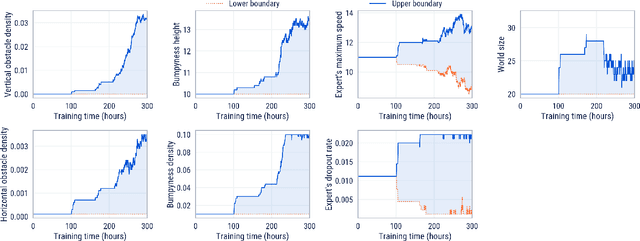


Abstract:Cultural transmission is the domain-general social skill that allows agents to acquire and use information from each other in real-time with high fidelity and recall. In humans, it is the inheritance process that powers cumulative cultural evolution, expanding our skills, tools and knowledge across generations. We provide a method for generating zero-shot, high recall cultural transmission in artificially intelligent agents. Our agents succeed at real-time cultural transmission from humans in novel contexts without using any pre-collected human data. We identify a surprisingly simple set of ingredients sufficient for generating cultural transmission and develop an evaluation methodology for rigorously assessing it. This paves the way for cultural evolution as an algorithm for developing artificial general intelligence.
Predictive Closed-Loop Service Automation in O-RAN based Network Slicing
Feb 04, 2022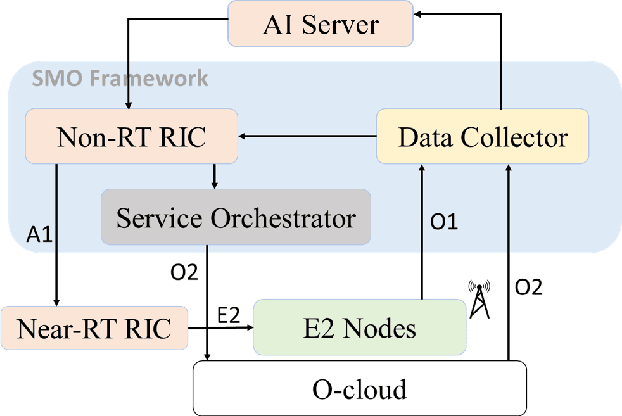
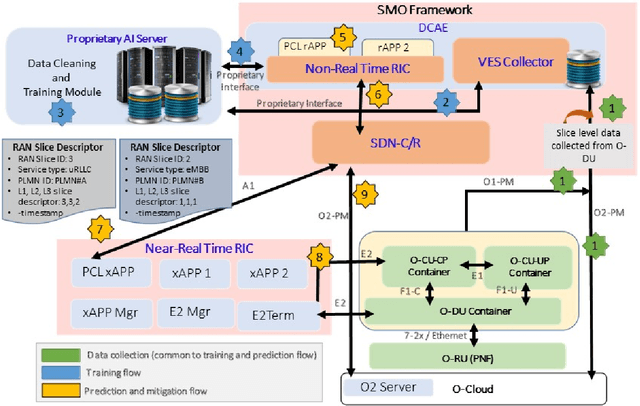
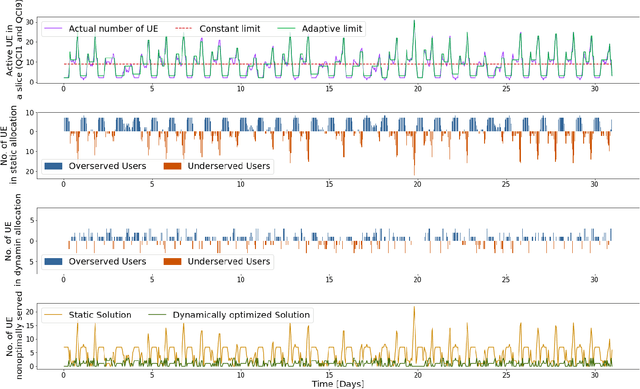
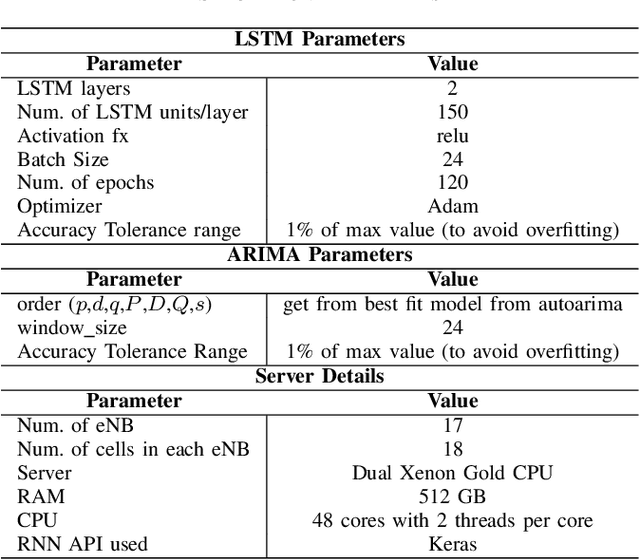
Abstract:Network slicing provides introduces customized and agile network deployment for managing different service types for various verticals under the same infrastructure. To cater to the dynamic service requirements of these verticals and meet the required quality-of-service (QoS) mentioned in the service-level agreement (SLA), network slices need to be isolated through dedicated elements and resources. Additionally, allocated resources to these slices need to be continuously monitored and intelligently managed. This enables immediate detection and correction of any SLA violation to support automated service assurance in a closed-loop fashion. By reducing human intervention, intelligent and closed-loop resource management reduces the cost of offering flexible services. Resource management in a network shared among verticals (potentially administered by different providers), would be further facilitated through open and standardized interfaces. Open radio access network (O-RAN) is perhaps the most promising RAN architecture that inherits all the aforementioned features, namely intelligence, open and standard interfaces, and closed control loop. Inspired by this, in this article we provide a closed-loop and intelligent resource provisioning scheme for O-RAN slicing to prevent SLA violations. In order to maintain realism, a real-world dataset of a large operator is used to train a learning solution for optimizing resource utilization in the proposed closed-loop service automation process. Moreover, the deployment architecture and the corresponding flow that are cognizant of the O-RAN requirements are also discussed.
 Add to Chrome
Add to Chrome Add to Firefox
Add to Firefox Add to Edge
Add to Edge